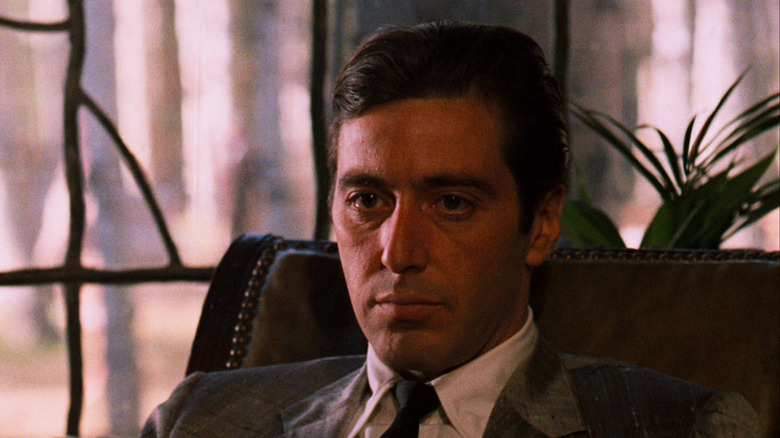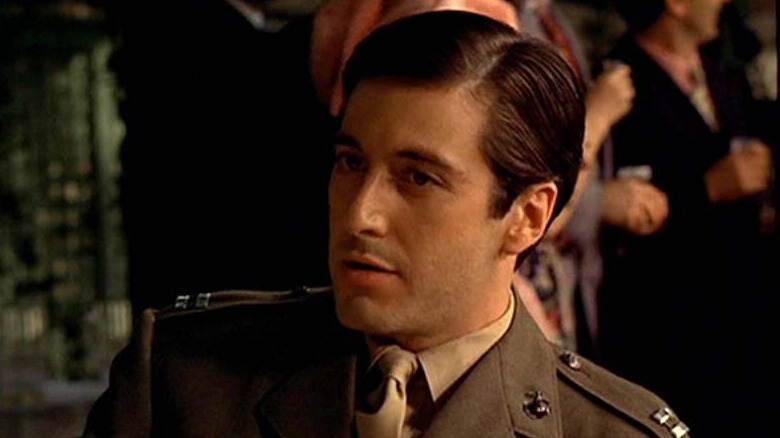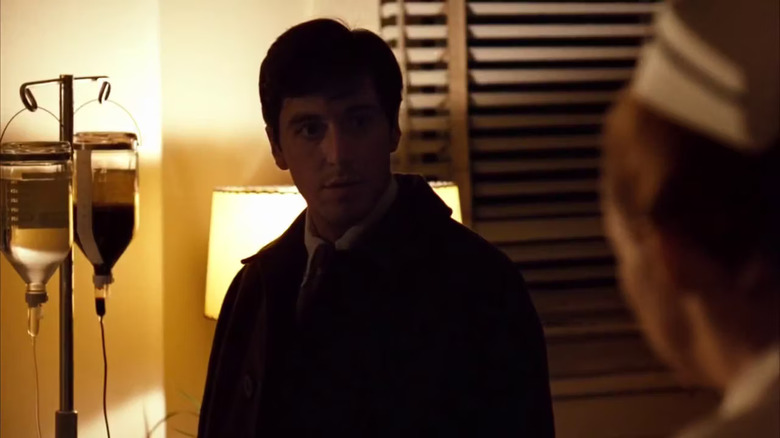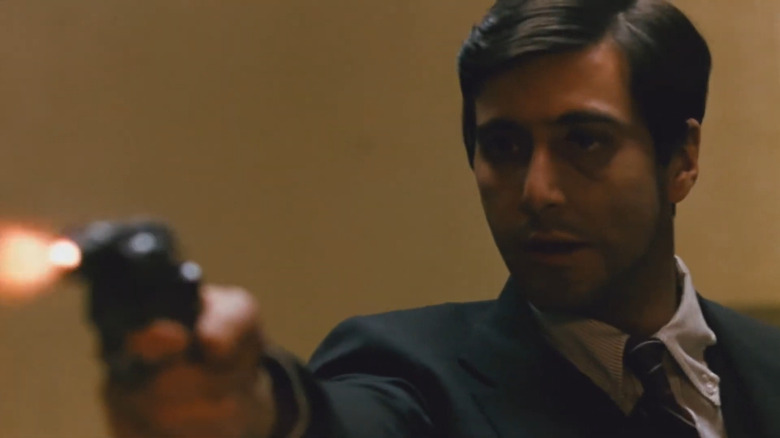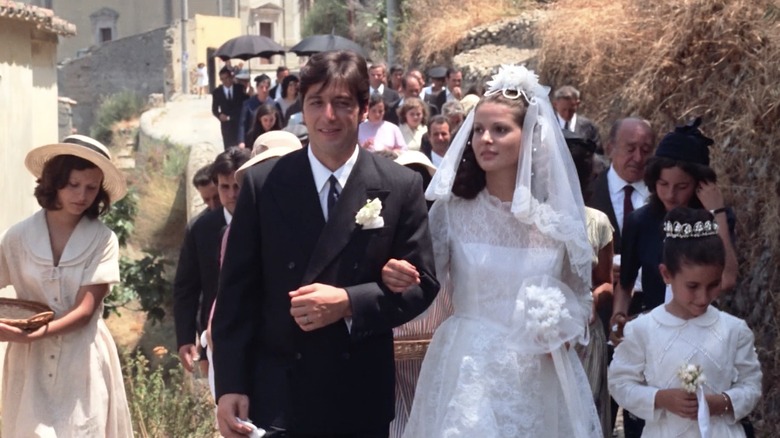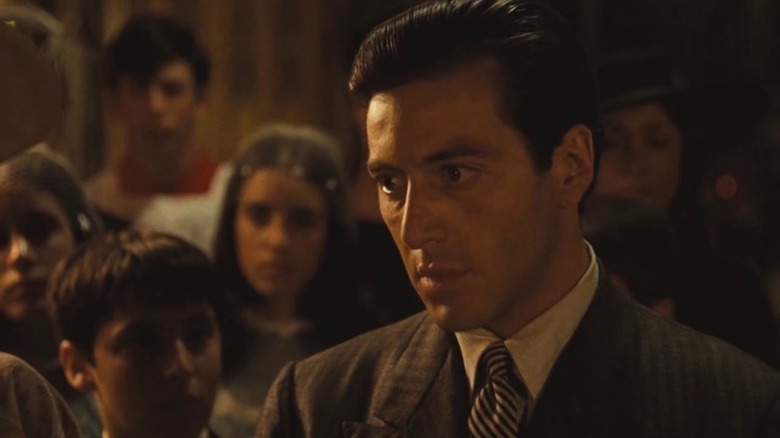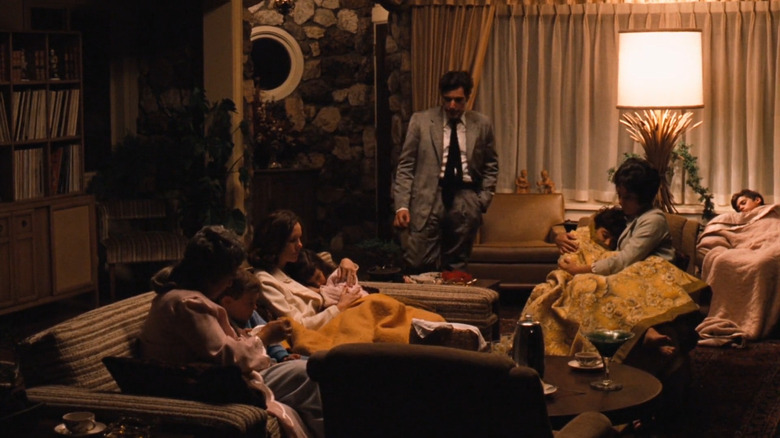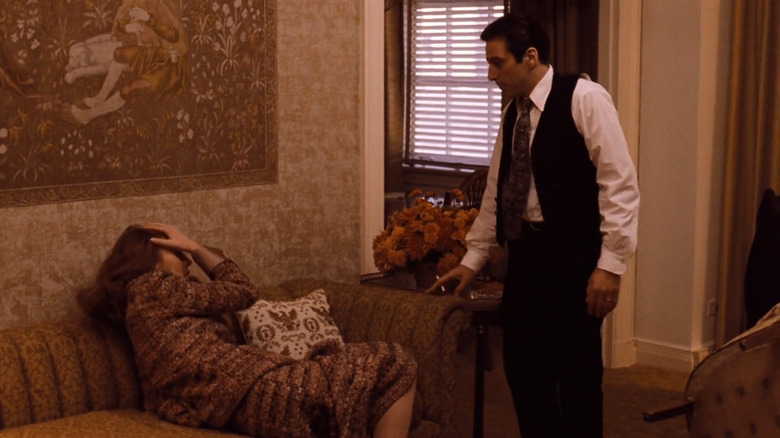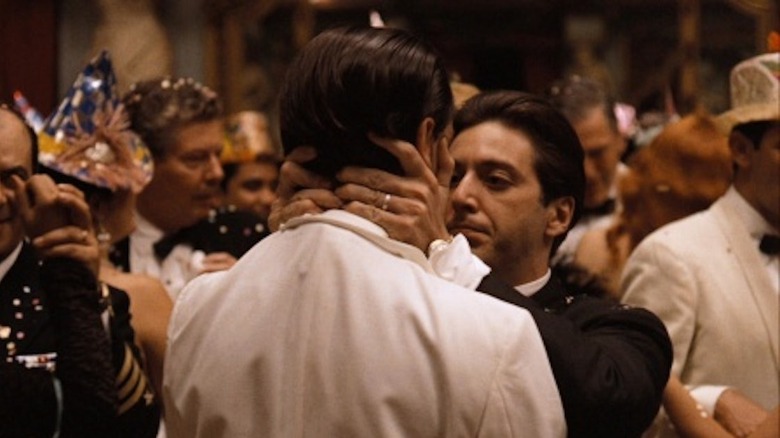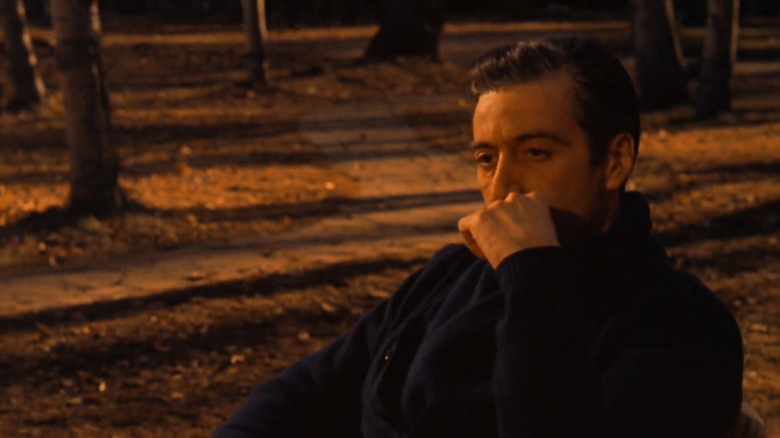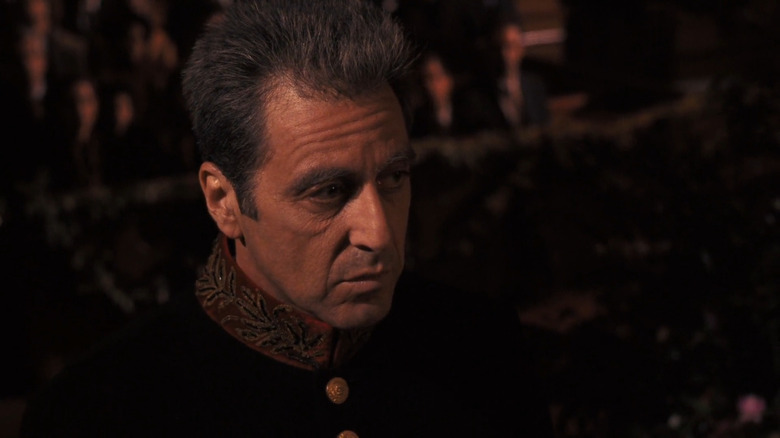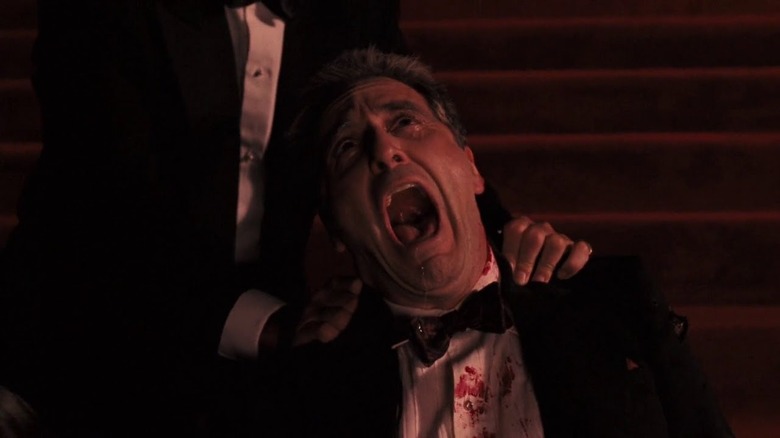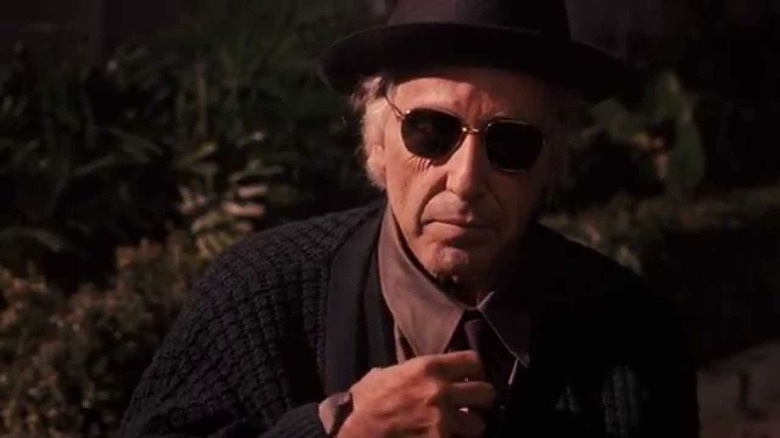The Transformation Of The Godfather's Michael Corleone
In the hallowed halls of cinematic classics, few films are held in as high a regard as Francis Ford Coppola's "The Godfather." It's a film that tackles many topics, not least of which is the corruptive nature of one's own family. We see how, despite one's best efforts to avoid it, you cannot escape the duties one must accept when in a position of power. This is best exemplified through the character of Michael Corleone (Al Pacino), the son of a powerful mob boss.
Over the course of "The Godfather" trilogy, we see Michael go through a staggering metamorphosis, each film showing another extended section of his turbulent life. We get to see a bright-eyed innocent eventually chewed up and spat out by the very world he intended to stay away from. But just how did Michael attain his power in the first place and what events led to his eventual heartbreaking downfall? Let's break down "The Godfather" trilogy's events and discuss the transformation of Michael Corleone.
Michael returns from the Marines
When "The Godfather" begins, we meet the Corleones, a highly respected and feared mob family run by Don Vito Corleone (Marlon Brando). Vito deals with some mob-related business while a gigantic wedding for his daughter is going on outside. This began a trend of each "Godfather" movie beginning with a large family event, often a source of levity ahead of the eventual brutality and heartbreak to come. It's also where we are first introduced to Michael Corleone, just back from the Marines, as well as his girlfriend Kay Adams (Diane Keaton).
In these early scenes, we get a clear sense that Michael has yet to be corrupted by his family's shady and often violent dealings. He makes this especially clear to Kay, who's troubled when Michael pulls back the curtain ever so slightly on his family's line of work. Michael, though making it clear that it's his family's business and not his, does make this point with some mild intensity. This is Michael at his most innocent, a far cry from his state at not just the end of the first film, but the trilogy as a whole.
Called to action
After not playing ball with the head of another mafia family, Vito is shot in the middle of the street, forcing his hospitalization. Michael discovers his father's state when out in the city with Kay, where he sees a newspaper headline reporting the entire incident.
Michael quickly dashes to the hospital where his father is being looked after, only to discover that the entire place has been cleared out. With no guards or any kind of, Vito is helpless and extremely vulnerable to any matter of follow-up attacks from his enemies. Michael quickly deduces this and springs into action, convincing a lone nurse to help him move Vito into another room. He's then greeted by Enzo (Gabriele Torrei), a friend of the family whom his father helped in the past, who's visiting to check in on Vito. After sending Enzo outside to pose as a guard, Michael shares a tender moment with Vito, telling his father that he's here to protect him.
Shortly thereafter, Michael is confronted outside by Mark McCluskey (Sterling Hayden), a corrupt police captain, as well as a few of his men. After some heated words, Michael is severely beaten by the police until Tom Hagen (Robert Duvall) and some of Vito's associates arrive and de-escalate the situation. It's not only masterfully suspenseful but gives us just a small taste of just how smart Michael can be, quickly taking control of the situation in his own way.
Michael draws blood
After the hospital incident, Michael finds himself dragged into his family's mafia activity. It seems Michael's heated interaction with McCluskey has led to some tension between the Corleones and drug kingpin Virgil Sollozzo (Al Lettieri). This is due to McCluskey being on the payroll of Sollozzo, the latter of whom ordered the hit on Don Corleone in the first place.
Sollozzo seemingly wants to smooth the situation over, but Michael's older brother Sonny (James Caan), the acting Don, suspects something sinister. Looking to take matters into his own hands, Michael pitches the idea of meeting with Sollozzo and McCluskey for a sit down where he would kill them. Tom Hagen, the family's lawyer, advises against this as the fallout could reignite a war between the various mob families. Despite Hagen's recommendations, Sonny opts to approve Michael's idea and begins helping him in planning out the hit.
The night eventually arrives and Michael, after fishing a hidden gun out of the bathroom, kills both men point blank in the middle of a restaurant. Not only is it one of the film's most brutally violent scenes — it also shows that Michael's descent into darkness has officially begun. The innocent Marine we met in the film's opening scenes is slowly but surely accepting his role within his family's dark, destructive dealings.
Michael's time in Italy
Following the murders of Sollozzo and McCluskey, Michael's family wisely gets him out of the country for a while to avoid the fallout. To ensure his protection, Michael is sent to live in Sicily under the watch and protection of Don Tommasino (Corrado Gaipa), an ally of the Corleone family. It's here Michael gets a little reprieve to enjoy life, which isn't difficult amongst the landscapes of Sicily. He also falls in love with a local woman named Apollonia Vitelli (Simonetta Stefanelli) before eventually marrying her with the intention of spending the rest of his life with her.
Meanwhile, back in America, Sonny is violently gunned down by a siege of gangsters at a toll booth. Michael is informed of his brother's death and ends his time abroad, seeking to return to America with his new wife. However, just before they depart Sicily, a car bomb intended for Michael goes off with Apollonia still inside the vehicle, killing her. For the first of what will be many times, Michael's dealings with the family business have cost him something he loves. This is a key moment for Michael's still-ongoing transformation, as the death of his wife ignites his role as the head of the Corleone mafia.
Michael takes down the five families
After his return to America, Michael reunites with Kay and marries her. They have two children named Anthony and Mary. It's also during this time that, due to Vito's waning health and Fredo (John Cazale) not fit to lead, Michael steps in as the new Don. Michael's transformation really reaches its apex as he is now more than willing to crank up his ruthlessness when needed. Not only is his body language different — far more rigid and confident — but his eyes are far more withdrawn and threatening.
This final transformation is cemented during the baptism scene, quite possibly the film's most iconic moment. It's here Michael takes control of the Corleone mob. Prior to his death, Vito tells Michael that Don Emilio Barzini (Richard Conte), the man responsible for Sonny's death, will be coming for Michael next. This prophecy is soon revealed to be accurate, so Michael takes action in the most brutal way possible — he wipes out the heads of all five mafia families. As Michael attends the baptism of his sister Connie's child, we're treated to a brutal sequence of the five heads being taken out in gruesome fashion. Not only is the sequence a testament to Coppola's stellar direction but it effectively cements Michael's dark descent into a life of crime.
Michael's life is threatened
Michael's life as the Don becomes increasingly more difficult in the events of "The Godfather Part II," set three years after the first film. When we're reintroduced to the Corleone family amidst yet another large gathering, Michael is firmly set as Don. Michael is even introduced similarly to Vito in the first film, boasting an intense yet withdrawn stare while cast in heavy shadow. The kind and bright-eyed young man from the first film is all but already become a distant memory, replaced by an eerily broken person. There's a sense that Michael is becoming increasingly more disillusioned with his role, though he's forced to keep up a dominant facade.
Things get knocked for a serious loop when, much like his father before him, Michael's life is nearly lost in a mob hit. Late one night, a barrage of gunshots tears apart Michael's home that gets "The Godfather Part II" off to a suitably epic start. Almost immediately, Tom Hagen deduces that the only way this could've happened is if someone within the family was secretly in on it. This results in Michael, very understandably so, being a bit more paranoid and on edge, another factor affecting his crumbling mental state.
Michael and Kay's doomed marriage
One of the major casualties of Michael's commitment to the corruptive mafia life is his marriage to Kay. Even from the film's early scenes, it's clear their marriage is insecure and has likely been that way for some time.
It's very clear that Kay, despite Michael's insistence in the first film that his business would be "legitimate" soon, has become disillusioned. Their marriage feels strained and despite sharing a lovely dance at the party, there's a sense of unease. This feeling persists into the following scene where Michael talks to Kay just prior to their house being attacked. In a sound design choice that can be taken a few different ways, just before the bullets start flying, there's the sound of thunder in the background. This could simply be ambience or it could be in reference to the approaching storm that awaits Michael in the months to come.
Earlier in the film, Michael was told that Kay had miscarried their next child, only for her to reveal that she'd actually had an abortion. This leads to a horrifically unpleasant scene where not only does Michael strike her, he exiles her from the family and takes the kids as well. It's another prime example of just how far Michael has fallen, with Kay taking extreme measures to avoid bringing another one of his kids into the world.
Michael has Fredo whacked
"I know it was you, Fredo. You broke my heart." Those are the words Michael shares with his brother Fredo after uncovering his true level of allegiance to the family. As mentioned earlier, following the attempt on his life, Tom Hagen says to Michael that someone in the family was likely in on the hit job.
It isn't until they're watching a show at the club that Michael finally figures out that it was Fredo who sold him out. It becomes clear that Fredo knows Johnny Ola, the right-hand man of mob boss Hyman Roth, the likely suspect for who organized the hit on Michael. After this discovery, things are irreparably damaged between Michael and Fredo, with Fredo believing he should've been the one to take over when Vito died. Michael banishes Fredo from the family but says that he won't be harmed as long as their mother Carmela (Morgana King) is alive.
Carmela eventually passes on, which serves as a cue for Michael to begin tying off loose ends, including Fredo. Despite Connie (Talia Shire) doing her best to convince him to forgive Fredo, his time is officially up. One day while out fishing with Neri, Fredo is shot in the head and subsequently dumped into the water, all while Michael looks on with a somber glare.
Michael has nearly nothing left
What's important to note about "The Godfather Part II" is that it's telling two stories intertwined – Vito's rise to power and Michael's fall from grace. The former is set in the early-1900s and tells the story of a young Vito Corleone (Robert De Niro) working his way up the mafia ladder. This not only gives the film a compelling structure, cutting back and forth between timelines but provides some nice narrative symmetry.
As we see Vito steadily and violently build what will one day be the Corleone crime family, we have a front-row seat to see it all burn down. By the time the credits roll, Michael has lost his wife and set up the murder of Fredo just to protect the security of the family business. Now bear in mind that this means that not only is Michael's marriage finished but his entire immediate family are all dead. The last we see of Michael in the film, he sits alone on a bench, staring out into space. Though judging by the music and Michael's thousand-yard stare, we can safely assume he's wondering just how everything could go so wrong. This somber conclusion is the first taste of the more mentally withered Michael we end up seeing in "The Godfather Part III."
Michael's reign comes to an end
It's worth noting that, compared to its two predecessors, "The Godfather Part III" wasn't regarded quite as fondly by fans and critics. That being said, the film is by no means horrendous and still boasts many of the qualities that made the first two so great. Case in point, the final chapter of Michael's character and the end result of what his poor decisions have wrought.
The main crux of the third film is seeing the current state of Michael and just how broken he's been made by his line of work. When we catch up with Michael at the beginning of the film, at yet again another family gathering, he's in his late 50s. Long gone is the hopeful young man we met back in the first film, replaced by a worn-out man with ample regrets.
One of the many subplots active in the film regards Vincent (Andy Garcia), Sonny's son from out-of-wedlock who, in a very bizarre move, becomes romantically involved with Michael's daughter Mary (Sofia Coppola). creepy romance aside, this development results in Michael, after some deliberation, naming Vincent as the new Don after he chooses to step down. This goes hand-in-hand with Michael attempting to leave the mafia life behind before it can take anything else away from him, which as we learn is wishful thinking.
The death of Mary Corleone
One cannot talk about "The Godfather Part III" without talking about Michael's daughter Mary Corleone. Mary is a major part of the film's narrative, especially when it comes to her off-putting romance with her cousin Vincent. It's very clear that Michael is still very protective of Mary, thus his desire to keep her and Vincent apart due to the latter's organized crime affiliations. Little did Michael know just how well-founded his fears were, especially when the film's shocking climax rolls around. After a night at the opera, yet another attempt on Michael's life is made on the stairs of the building.
Following some gunshots, Michael is wounded but then looks over to see Mary, who has been hit in the chest. We're then treated to a tragic image of Mary's parents cradling her as she dies, with Michael letting out a blood-curdling scream. Despite his best attempts to walk away, it seems the powers that be needed to take one last thing from Michael ... his daughter.
Michael's long life
With one of his own children now dead because of his own past sins and decisions, Michael has truly become a broken man. However, when it comes to the film's final image of Michael, this is where things get a bit interesting. In 2020, "The Godfather Part III" was recut to better fit the vision that Coppola and Puzo originally envisioned – with resequenced scenes and altered musical cues.
One such change appears during the ending which originally sees a frail and gaunt-looking Michael, clearly at the end of his life. It's very surreal to see Michael decked out in old-age makeup just like Brando had back in the first film, a true full-circle moment. We see Michael, bereft of any company, simply succumb to his old age and fall out of his chair onto the ground. Once again, this is very similar to how Vito died in a rather unremarkable fashion while playing with a young Anthony in the first film.
In the recut version, however, the film instead fades from old Michael to a quote that reads:
"'When the Sicilians wish you 'Cent'anni', it means 'for long life'...and a Sicilian never forgets.'"
Michael has indeed been blessed with a long life, though considering the state of him and how much he's lost, it might just have been a curse.
